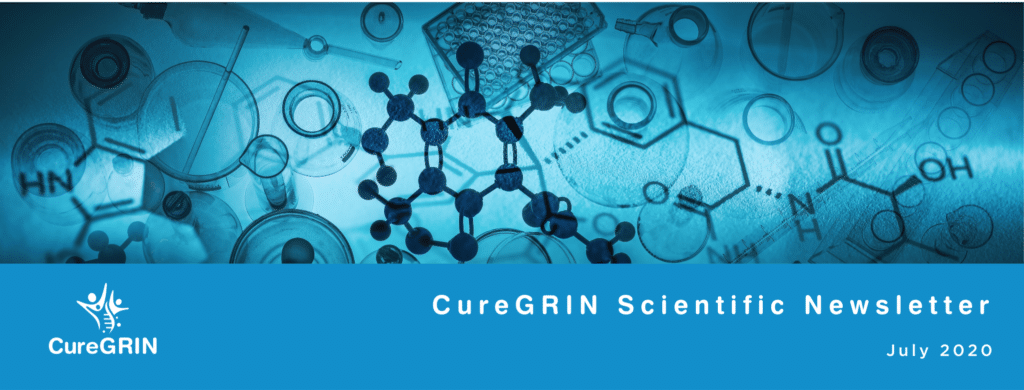Cure GRIN Scientific Newsletter – July 2020
Share This Post

Welcome to the first edition of CureGRIN Foundation’s new scientific newsletter.
Every two months, we’ll be sharing updates on the latest publications about GRIN genes, NMDA receptors and other glutamate receptors. We’ll also be talking about new developments in seizure treatments and other GRIN symptoms.
In this first edition, CureGRIN’s research coordinator Meagan Collins summarizes the findings of four recent peer-reviewed scientific research articles. First, we discuss articles published in Brain and learn about predictions for the number of people with GRIN Disorder. We then discuss an article published in Cell describing the structural features and functioning of the NMDA receptors. Next, we discuss the findings of an article published in Human Mutation which looked at NMDA receptor functioning in 18 patients with GRIN Disorder. Finally, we highlight the suggestions on how to pursue personalized medicine for GRIN Disorder patients from an article published in Neuropharmacology.
How many people have GRIN Disorder?
A study published in Brain suggests that GRIN Disorder might not be quite as rare as previously thought. This study used bioinformatic tools to predict the incidence, or the number of cases of a disease during a given period of time in a population, of single gene (monogenic) neurodevelopmental disorders. A member of CureGRIN’s Scientific Advisory Board, Dr. Johannes Lemke, published an article in the same issue of Brain providing comments and discussing the findings of this study.
Using the algorithm of López-Rivera and colleagues, Dr. Lemke calculates that GRIN Disorder due to variants in either GRIN1, GRIN2A, GRIN2B or GRIN2D occur in one out of every 5,208 births (19.2 per 100,000).
For GRIN1, the predicted incidence per 100,000 births is 5.45, meaning that out of every 100,000 babies born, roughly 5 babies would have a de novo missense variant in GRIN1. The predicted incidence per 100,000 births for GRIN2A is 3.23, GRIN2B is 5.91, and GRIN2D is 4.61. Even if we assume that people with GRIN Disorder will have a shorter average lifespan, this estimate could put the number of people living with GRIN Disorder around the world at between 1 million and 2 million. Though Dr. Lemke finds some limitations in the López-Rivera and colleagues research, he says that this statistical method will be a useful tool until we have larger epidemiological studies on rare disorders available.
To learn more, check out our recent blog post and visit: López-Rivera JA, Pérez-Palma E, Symonds J, et al. A catalogue of new incidence estimates of monogenic neurodevelopmental disorders caused by de novo variants. Brain. 2020;143(4):1099‐1105. doi:10.1093/brain/awaa051 and Johannes R Lemke, Predicting incidences of neurodevelopmental disorders, Brain, Volume 143, Issue 4, April 2020, Pages 1046–1048.
Visualizing the molecular blueprint of NMDA receptors
A new study published in Cell by Dr. Hiro Furukawa and his colleagues expands upon our understanding of the structure and function of the NMDA receptor. These findings will allow for researchers to design better strategies to modulate the activity of the NMDA receptor.
Using electron cryo-microscopy (cryo-EM) and x-ray crystallography, the researchers achieved high-resolution structural analysis for the NMDA receptor, as well as determined the transitions and changes in movement of the receptor upon ligand binding. The researchers found that when GluN1 agonists (glycine) and GluN2 agonists (glutamate) are bound, the NMDA receptor has three major conformational states (“Non-active1,” “Non-active2”, and “Active”). These conformational states result in changes in movement and orientation of the transmembrane domains and ligand-binding domain (LBD) as well as the activity of the ion channel. When in the “Active” state, the LBD of the NMDA receptor opens the gate of the ion channel.
The researchers also looked at conformational changes when different combinations of a GluN1 antagonist (L689,560 (L689)) and a GluN2 antagonist (SDZ-220-040 (SDZ)) were bound. They found that the antagonists work by relaxing the linkages between the receptors and the ion channel. The binding of GluN1 andGluN2 antagonists results in inhibition by disengaging LBD from the ion channel such that the gate of the ion channel cannot open.
Overall, the results of this study demonstrate the mechanism of conformational changes of the GluN1-GluN2 hetero-tetramer, providing a blueprint for how the NMDA receptor works, which will allow for the improvement of potential targeted therapies in the future.
To learn more: Chou TH, Tajima N, Romero-Hernandez A, Furukawa H. Structural Basis of Functional Transitions in Mammalian NMDA Receptors [published online ahead of print, 2020 Jun 26]. Cell. 2020;S0092-8674(20)30685-1. doi:10.1016/j.cell.2020.05.052
Towards personalized medicine for GRIN Disorder patients
Due to the genetic and phenotypic complexity of GRIN Disorder, finding treatments that work for patients has proven difficult. Precision medicine is a new approach for the treatment of diseases which accounts for the genetics, environment, and lifestyle of individual patients. A recent review article published in the scientific journal Neuropharmacology focuses on examples of precision medicine treatments for epilepsy disorders, the challenges of these treatment approaches, and new strategies to for future research. This article discusses the challenges related to assessing outcomes and gradual improvements over time for GRIN Disorder treatments.
The researchers suggest that thorough clinical trials with proper outcome measures will be essential to establish precision medicine treatments for GRIN Disorder. The researchers also suggest that electronic medical records could be used to extract information to allow for a more standardized form of phenotyping for genetic epilepsies. By using electronic medical records, researchers could analyze clinical features of patients over time.
To learn more: Helbig I, Ellis CA. Personalized medicine in genetic epilepsies – possibilities, challenges, and new frontiers. Neuropharmacology. 2020;172:107970. doi:10.1016/j.neuropharm.2020.107970 (https://pubmed.ncbi.nlm.nih.gov/32413583)
GRIN variants in the NMDA receptors are associated with neurological diseases
An article published by Dr. Stephen Traynelis, a member of CureGRIN’s scientific advisory board, and his colleagues in the scientific journal Human Mutation, investigated the functioning of the NMDA receptors in 18 patients with de novo variants in GRIN genes. This study provides us with more understanding about how variants in GRIN genes affect the functioning of NMDA receptors, particularly that certain missense variants in the M2 pore loop region tend to be gain-of-function. This study can help us with diagnoses and determining the possible functional phenotype of patients with similar variants in the future.
NMDA receptors play an important role in helping neurons in the brain to communicate with each other (Bliss & Collingridge, 1993). Most GRIN patients have what is known as a de novo (‘new’) gene variant in one of the GRIN genes which encode the NMDA receptors. The de novo variant in one of the GRIN genes results in GRIN Disorder, which is characterized by a variety of different neurodevelopmental symptoms, such as developmental delay, intellectual disability, and epilepsy. In this study, there are 4 patients with GRIN1 variants, 7 patients with GRIN2A variants, and 7 patients with GRIN2B variants. All 18 patients displayed some form of intellectual disability or developmental delay, and nine of the patients had seizures. In 12 patients with de novo variants located in a certain region (the M2 pore loop region) of the NMDA receptors, there were effects on functioning of the NMDA receptors.
NMDA receptors are classified as ionotropic receptors. These types of receptors form channels that ions (such as calcium (Ca2+)), can move through, after neurotransmitters, such as glutamate or glycine, have bound to them. Calcium ions flow through the channels and are critical for synaptic plasticity and learning and memory. Normally, magnesium ions (Mg2+) block other ions from flowing through the channels. The NMDA receptors in these 12 patients have reduced sensitivity to magnesium and reduced permeability of calcium ions. For these patients, there is a lack of Mg2+ blocking, which allows more ions to enter the cell than under normal conditions. In most of these patients, there is enhanced function of the NMDA receptors, meaning that most of the variants are considered gain‐of‐function variants.
These findings can allow researchers to compare variants found in other patients in the future to help determine the functioning of the NMDA receptors in these patients.
To learn more, check out our blog post on NMDA receptors and visit: Li J, Zhang J, Tang W, et al. De novo GRIN variants in NMDA receptor M2 channel pore-forming loop are associated with neurological diseases. Hum Mutat. 2019;40(12):2393‐2413. doi:10.1002/humu.23895 (https://pubmed.ncbi.nlm.nih.gov/31429998/), Bliss, T., Collingridge, G. A synaptic model of memory: long-term potentiation in the hippocampus. Nature 361, 31–39 (1993). https://doi.org/10.1038/361031a0 (https://www.nature.com/articles/361031a0)
About Us
This newsletter is assembled by CureGRIN Foundation. Our goal is to find cures and therapies for people around the world living with disease-causing GRIN gene variants. We know that for this to happen, clinicians, researchers, biotech companies and patient advocates need to collaborate. We want to accomplish these goals with your help! Contact me here.
Keith
Keith McArthur, Chief Executive Officer and Head of Science
CureGRIN Foundation
www.curegrin.org
keith@curegrin.org
Contact Us
CureGRIN Foundation
5732 Regal Oak Lane
Parker, Colorado 80134
(303) 881-3425
Read more Posts

Count Me In 2021
CureGRIN is looking for GRI Families to help us raise $250,000 to fund research for a cure for GRI Disorder.

Accessing GRI gene models
Share This Post Are you a researcher interested in accessing GRI gene animal models, patient variant animalmodels, patient-derived induced pluripotent stem cells, and/or patient samples?
